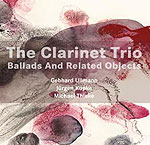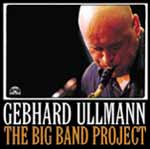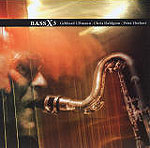
Pushing the envelope
|
This review first appeared in Turbula in May 2005.
German reedman Gebhard Ullmann is unknown to even most hardcore American jazz fans. Three simultaneous releases under his name should go far in changing that – although given the edgy, experimental nature of his work, his reknown is likley to remain among that small number of fans who appreciate truly avant-garde exploration.
The Clarinet Trio is the most out-there of the three: Shades of Henry Threadgill and David Murray and old Art Ensemble of Chicago. Art of noise grunting and honking, atonal rhythmic blowing, seemingly aimless digressions, baby talk through a reed. And then they turn gears mid-song, and now you're in a passage as lush as "Swan Lake" – before it decomposes into some weird klezmerific ensemble improvisational noodling.
Teaming up with fellow clarinetists Jürgen Kupke and Michael Thieke (with Ullmann on bass clarinet and Thieke on alto clarinet), the Trio produces haunting, atmospheric music as challenging as anything from the discography of the musicians offered as comparisons above.
And yet, it is nevertheless fascinating, intriguing and able to hold your interest for the pure pleasure of hearing where they might go with this musical oddness.
For his Big Band Project, Ullmann teams up with the respected NDR Big Band, based out of Hamburg. Closer in spirit to the combos of Stan Kenton or Toshiko Akiyoshi than Glenn Miller, NDR Big Band provides a foil for Ullmann that is nearly as daring as he.
As with the Trio, all the songs on the Big Band Project were written by Ullmann. There are some guest arrangers here, including Satoko Fuji – another avant-garde jazzster, and one with a bit more name recognition in the States than Ullmann.With a big band, there is obviously a fuller sound here than with the Trio; it is a different voice, but the addition of the big band in no way mellows Ullmann's edge. It is every bit as challenging as the Trio release. The music here can switch from a march to wall of noise in a heartbeat; the change makes Haydn's Surprise Symphony seem a Carpenters' tune by comparison.
By far the most out-there of the three new releases is "Bass X 3," with Ullmann's bass clarinet and bass flute backed by two double-bass violins (Chris Dahlgren and Peter Herbert). It's a sonic locomotive rumbling through your stereo and living room, rattling the windows, the china and probably your fillings, too.
Intriguingly, the compositions themselves are somewhat restrained, at least compared to the other two albums from Ullmann. Straight-forward, often bordering on melodic, the eight tunes here are much more streamlined than those on the other albums.
Instead, on "Bass X 3" it's the textures that are so challenging. That deep, thick undercurrent of bass on this album shades every note it contains. It's like a painting done in varying shades of black.
But what shades! Who knew that the lower register held so much weirdness. Normally the domain of the majestic, here the lower octaves are harbingers of puns and silliness.
Like the Trio and Big Band outings, "Bass X 3" makes for lousy background music but for very, very good brain food.


